
NIGHT OF EUROPEAN SOY – WSRC 11 World Soybean Research Conference 18 – 23 June 2023 Vienna/Austria
BE HEALTHY and STAY HEALTHY

SOY POWDER from AUSTRIA
HIGH SPERMIDINE CONCENTRATION
Contains at least 1.7mg spermidine per tablespoon
Content: 40 portions
39.0g protein/100g
Made from genetically unmodified soybeans (NON GVO <0.1%)
Packaging: membrane sealed can Ø 99 x 180
Suitable for: vegetarians, vegans, kosher
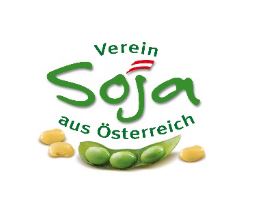

ORGANIC SOY POWDER from AUSTRIA
HIGH SPERMIDINE CONCENTRATION
Packaged in 25kg paper bags or Big Bags
Produced from genetically unmodified soybeans of organic quality (NON GVO <0.1%)
Storage: cool and dry
spermidine-soyup.com
www.nugenis.eu/shop
HISTORY of SOY from AUSTRIA
When the eminent botanist Nikolaus von Jacquin, one of the founders of the Vienna School of Botany, became head of the k.k. Botanischer Garten (Royal Austrian Botanical Garden) in 1768, it experienced a remarkable upturn.
Nicolaus Joseph von Jacquin was born in Leiden (Netherlands) and is regarded as a pioneer of botany in Austria. He is the author of groundbreaking essays in the field of botany and was the first to describe many plants, fungi and animals. In 1768, Nikolaus von Jacquin moved to Vienna where he was made Professor of Botany and Chemistry at the Medical School of the University of Vienna and also was appointed director of the newly founded Botanical Gardens, which he then restructured according to latest scientific guidelines.
His work Icones plantarum rariorum, published in 1781-1793 in 3 volumes, contains 648 coloured copperplate prints including one showing a soy plant.

Figure: Dolichos Soja, synonymous for Glycine max (L.) Merr.
Coloured copperplate print from “Icones Plantarum Rariorum”. Baron Nicolaus Joseph of Jacquin, Vindobonae [Vienna], Christian Friedrich Wappler, 1781
Measurements: 48.5cm x approx. 30cm, plate approx. 44cm x 19cm
Presumably, this is the very first depiction of a soy plant grown on Austrian soil, in colour and with far more precise botanic detail then one seen in an earlier drawing of Engelbert Kaempfer who described the soybean after visiting Japan in 1691/92.
Soy plants were on show at the Vienna World Fare in 1873 and it was there that Friedrich Haberlandt noticed the plant and in particular the soybean and developed not only a personal but also a scientific interest. In Gartenpalais Schönborn, today housing the Volkskunde Museum (Austrian Museum of Folk Life and Folk Art), he directed first cultivation trials with soy plants. He envisioned this plant to be of major importance as a food crop and also have influence on the national economy.
From June 19th to June 23rd 2023, Vienna will host the 11th Word Soybean Research Conference for the first time.

The “Night of European Soy” will take place on June 19th, 17:00 at the Vienna Weltmuseum at Heldenplatz and offers a soy-based buffet and a soy exhibition. There, the actual box of soybeans will be on display that was on show at the Japanese stand at the Vienna World Fair in 1873.

Figure: Wooden box from Japan with original soybeans and edamame plants grown in the garden of the Volkskunde Museum (Museum of Folk Life and Art) in Vienna.
Austria was a world centre of excellence for soy research
Austria in the 1920s was a world centre for soy research. Apart from cultivation, there were improvements in soy processing. Ladislaus Berczeller’s groundbreaking method of soy flour production opened up countless new opportunities for using soy for feeding the local population as the flour can be added easily to many dishes to make them more nourishing at low cost and without changing their taste. There was much enthusiasm about the flour and interest increased even more after the Great Depression.
In order to become less dependent on foreign imports, cultivation of soybeans on Austrian soil was of great interest, for it would make the young republic more self-sufficient. Franz A. Brillmayer successfully bred soy varieties that grew well in the Central European climate.
-Brillmayer, Bedeutung der Ernährung (On Nutrition), page 88

Picture: Prof. Dr. Laszlo Berczeller of Vienna, international authority on nutrition, says: “Yeast is one of the few foods which definitely improve health”.
New Yorker. April 27. 1929., p. 33.
László Berczeller, born in 1890 in Budapest; died 1955, was a Hungarian physician, bio- and food chemist. His main interest was soy and he is regarded as one of the most important pioneers in the field of soy-based foodstuffs in Europe.
Berczellers started to take an interest in soy in 1913 in Berlin. He had been invited for dinner at the Japanese Club and was introduced to a professor from Japan who gave him his first insights into soy-based foods. In 1914, Berczeller became professor of biochemistry at the University of Budapest. When the World War I started, he was recruited to work for the government, most likely in Vienna. He then worked for a certain Dr Wasserman in Vienna and had the post of an assistant researcher with Professor Franz Tangel. It was presumable while he worked at the Physiologischen Institut (Physiological Institute) at the University of Vienna that he became aware of the work of Friedrich J. Haberlandt, who was also interested in soy.
From about March 1920 onwards, Berczeller cooperated with the chemist Robert Graham who researched into the possibilities of reducing the famine in Europe and Russia with soy flour. It is not clear, who was in charge. In 1921 however, it was Berczeller who applied for his first soy patent in Austria. The patent was granted in 1927 and was given the number 106.346. Berczeller and Graham both applied for a patent in Germany on January 26th 1921 and were granted it on November 16th 1924 with the number 406.170. Still in 1921, this time again in Austria, Berczeller applied for a further patent on using soybeans for bread making. This patent was granted on June 25th 1924 and had the number 97.252. This was followed by several further applications and patents in other countries. Berczeller, Graham and their coworkers first developed soy milk, soy flour and bread made with soy flour. Each of these products was given a name containing the word “manna” and from 1921 on, Berczeller published many articles on these foods. He emphasized the low production costs and the high nutritional value of his products. Because of his work with Graham, he got into conflict with the University of Vienna. He had already been reprimanded in 1920 for neglecting his duties at the university. He left the university in May 1921 and focused his research solely on soy-based food. It must have been around 1923 that he stopped working with Graham and continued his research on his own. In the 1920s and 1930s, his soy flour was unanimously referred to as the best soy flour available. Rinsed soybeans were steamed for 12 to 15 minutes and then dried, hulled and grounded. The flour could be stored at room temperature for 20 months and had no unpleasant aftertaste.

Picture: In 1916, the catastrophic famine swept the Habsburg monarchy. The first food riots broke out in Vienna in May 1916. Groups of emaciated youths looted food trucks and smashed shop windows,
Berczeller kept optimising his production method continuously and started travelling the world in the 1920s to raise awareness for soy foodstuffs. He benefitted from his extensive language skills and also met Winston Churchill in 1924. He visited the Soviet Union in 1926 and 1930 and was given the title of honorary general of the Red Army. 1927, the Italian ministry of war established the Commissione per lo Studio della Soja and in 1927 Berczeller had talks with Benito Mussolini on using soy flour in polenta and bread making; he also contacted the French government. He further had contact to Joseph Stalin, Dorothy Thompson and many other high ranking military officials from all over the world. He spent some time in London, travelled to Romania, Bulgaria, Yugoslavia and Portugal to promote the use of soy in food.
Source: : William Shurtleff and Akiko Aoyagi, Biography of Laszlo (Ladislaus) Berczeller (1890–1955) and History of his Work with Edelsoja Whole Soy Flour at www.soyinfocenter.com
In 1928, Sojaöl- and Sojamehlfabrik Dr. Winkler & Co (Soy Oil and Flour Factory Dr Winkler & Co) was built in the Vienna District No.20 and became the leading producer in Europe.

Many housekeeping magazines wrote highly about the Edelsoymehl (Finest Soy Flour) because “it agrees well with our taste and can be used in soups, vegetables, gravy, pastries, bread, sausages to improve quality and nutritional value while at the same time reduce production cost” (translation).
Source: Wo Österreich sparen könnte (How Austria could lower costs): Die Reichspost, November 12th 1926, page 11
SOY SPERMIDINE
The role of spermidine on cell health

Spermidine is a polyamine that occurs naturally in living organisms including plants and animals.
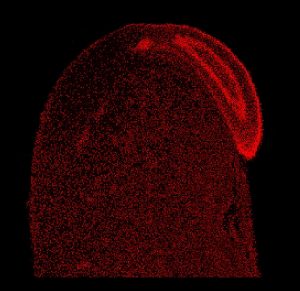
Figure: Spermidine distribution (red) in a soybean
Soy spermidine is an important growth factor and is of fundamental importance in cell growth (cell proliferation and cell differentiation), especially in the regulation of gene expression, in protein synthesis (transcription and translation) and further in the induction of autophagy and in resistance against oxidative stress (nitrosative stress and toxic stress as a result of a dysregulated HPA axis).
Spermidine: Bioactivity that supports a healthy and long life
Soy Spermidine and DNA methylation
Soy spermidine is an epigenetically active key molecule which together with ademetionine (S-adenosyl-L-methionine) protects cellular health.
Gene methylation status is closely linked to age related changes and spermidine metabolism intimately connected with regulation of gene methylation.
Age related changes to the DNA methylation status – increased demethylation in some sections and hypermethylation in other sections – are seen as key factor in developing age-related pathologies (ageing).
Soy spermidine protects from negative consequences of ageing and increases the life span
Altered DNA methylation related to ageing and the resulting pathologic changes can be prevented with a timely and adequate dietary provision of soy spermidine (for example soy powder containing a high concentration of spermidine) thereby prolonging life expectancy.
Spermidine, being a caloric restriction mimetic, prolongs life expectancy
Spermidine is an inducer of autophagy and provides energy when fasting or repairs stress related cellular damage.
Our body and our cells are continuously provided with food and thereby with energy leading to cellular growth which in turn is enhanced through insulin and insulin-like growth factors IGF-1 and mTOR. This means, our cells are continuously ageing. However, if we choose to fast for a period of time, levels of insulin, IGF-1 and also of mTOR stabilise again. This induces an intrinsic cellular self-cleansing process called “autophagy”.
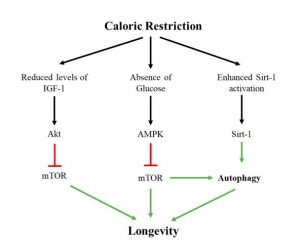
Figure: Caloric restriction has positive effects on autophagy induction signalling and therefore on the life span. In addition, increased activation of sirtuin-1 (sirt-1) under caloric restriction conditions induces autophagy and prolongs the life span.
Abbreviations: IGF-1 – insulin-like growth factor 1, mTOR – mammalian target of rapamycin, AMPK – AMP activated protein kinase, Sirt-1 – sirtuin 1
Molecular key events during caloric restriction (cr) and fasting on a molecular and metabolic level
Caloric restriction and fasting have effects at multiple levels and increase cellular and organismic multi-stress resistance which result in systemic health benefits.
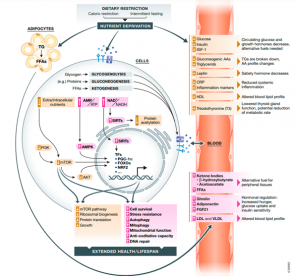
Abbreviations: AKT: protein kinase B/PKB, AMPK = AMP-activated protein kinase, AMP/ATP = ratio of adenosine monophosphate to adenosine triphosphate, BCAA = branched-chain amino acid, FFA = free fatty acid, FGF21 = fibroblast growth factor 21, FOXO = forkhead box protein O, IGF-1 = insulin-like growth factor, (V)LDL = (very) low density lipoprotein, mTOR = mammalian target of rapamycin, NAD+/NADH = ratio of oxidated to reduced nicotinamide adenine dinucleotide, NRF2 = Nuclear factor erythroid 2-related factor 2, PARP1 = poly[ADP-ribose] polymerase 1, PGC-1a = Peroxisome proliferator-activated receptor gamma coactivator 1-alpha, TG = triglyceride
Bruneck Study
The effect of spermidine on the lifespan of humans is being evaluated as part of a strategic project of the VASCage (Research Centre on Vascular Ageing and Stroke) group which was incorporated into the K1 Centre VASCage at the School of Medicine in Innsbruck.
The Bruneck Study recorded dietary habits of participants over a period of 20 years both qualitatively and quantitatively. Primary dietary sources of spermidine included whole grain foods, apples and pears, lettuce, vegetable sprouts and potatoes.
Actually, the level of dietary spermidine intake was inversely related to mortality rates: those who had a high intake spermidine as part of their diet showed a reduced risk of death over a 20-year follow-up period. A reduced level of autophagy is associated with nearly all age-related diseases and therefore it is not surprising to find positive effects of spermidine when deaths caused by vascular disease, tumours and other diseases are evaluated.
A diet rich in spermidine and spermidine supplementation correlate with increased survival rates in humans. Those with a high daily intake, at least 80mmol spermidine, show a significantly reduced risk of dying at a younger age.
According to this study, the risk of death in those who had a spermidine intake in the upper third and those who had an intake in the lower third (less than 60mmol a day) is equal to 5.7 years.
Sources:
Stefan Kiechl, et al. Higher spermidine intake is linked to lower mortality: a prospective population-based study, The American Journal of Clinical Nutrition, Volume 108, Issue 2, August 2018, Pages 371–380
Soda, K., Spermine and gene methylation: a mechanism of lifespan extension induced by polyamine-rich diet. Amino Acids 52, 213–224 (2020)
Soy spermidine has the ability to stimulate autophagy
One of the most important effects of soy spermidine on cellular health is its ability to increase the rate of autophagy. Autophagy is a cellular process in which damaged or aged cell components are degraded, recycled or removed and which is also a source of energy during starvation or used to repair stress-related damages in order to maintain cellular health.
An adequate level of autophagy is critical to protect cells from ageing, inflammation and various diseases.
In 2019, Frank Madeo and his co-workers at the Institute of Molecular Biosciences at the University of Graz have emphasized the importance of spermidine as a natural autophagy inducer on an increased lifespan.

Figure: The process of autophagy
Cytoplasmic components are surrounded by a membrane (the phagophore) which can extend to a double membrane autophagosome. Membrane fusion between autophagosomes and lysosomes generates autolysosomes; these contain acid hydrolases and permeases which can degrade the content of the cytoplasm and the lysosomal membrane. Degraded macromolecules will be recycled in the cytoplasm.
Induction of autophagy is linked to AMP-dependent kinase/mTOR independent signalling pathways and also to deacetylation reactions from autophagy associated proteins in the cytoplasm. In particular, spermidine induces autophagy by inhibiting acetyltransferase EP300.
Source: Eisenberg T, Knauer H, Madeo F et al. Induction of autophagy by spermidine promotes longevity. Nat Cell Biol. 2009 Nov;11(11):1305-14
Bio-spermidine plays a role in cell reprogramming and regulation of autophagy
Latest results have indicated that spermidine plays a role in cell reprogramming and the regulation of autophagy.
Reprogramming enables us to transform the cell nucleus of any cell in our body to an earlier embryonic developmental stage.
Soy spermidine can help to minimise oxidative damage in cells and increase protection against oxidative damage
Oxidative stress (ROS) is the result of an imbalance between pro-oxidative and anti-oxidative processes in our body and may lead to cell damage and inflammation.
Soy spermidine has anti-oxidative effects
Soy spermidine suppresses oxidative stress in cells (ROS stress), protects mitochondria and, as a result, all cells and organs.
A spermidine transporter controls spermidine levels during phases of oxidative stress and mediates the induction of anti-oxidative proteins (human anti-oxidation protein A1M)
Soy spermidine can boost the anti-oxidative effects of anti-oxidants if the anti-oxidant is given bevor, after or together with spermidine (Frank Madeo).
Soy spermidine is an anti-inflammatory
A chronically low level of proinflammatory cytokines and chemokines and the resulting increase of inflammatory biomarkers is linked to an age-related loss of function and to an increased risk of morbidity and mortality.
Soy spermidine has anti-inflammatory effects during acute and chronic inflammation due to its anti-oxidative and lysosome stabilising properties.
Soy spermidine improves the function of the immune system
Regulatory T-cells, abbreviated Treg cells, are a specialised subgroup of T-lymphocytes, mostly CD4+ T-cells, which regulate self-tolerance in our immune system.
Self-tolerance is the ability of the human immune system to differentiate between the body’s own and foreign matter.
Spermidine taken up from food helps to differentiate naïve CD4-positive immune cells leading to an increased production of Treg cells. Another effect is the reduction of the number of TH17 cells, a cell type which plays a major role in inflammatory reactions.
Soy spermidine promotes mitochondrial health
Normal and healthy functioning of mitochondria, also known as the power plants of cells, is promoted and maintained by spermidine. Spermidine can help to regulate the energy levels (ATP production) of the mitochondria to an ideal level and its antioxidative effects reduce ROS stress to which the proteins of the respiratory chain, the DNA, RNA and phospholipids are exposed. This protects mitochondria from oxidative ROS stress, ensuring good cell health and, as a result, good organ health.
Soy spermidine protects brain cells
Maintaining mitochondrial and autophagic pathways for improved cognition with spermidine supplementation is crucial.
Soy spermidine has positive effects in older people suffering from dementia.
Soy spermidine protects brain cells and the brain as a whole from oxidative cell stress, nitrosative stress and toxic stress by increasing HPA activity.
Soy spermidine plays a role in synaptic transmission and synaptic plasticity, both of which are fundamental to learning and memory.
The age-related loss of memory can be stopped by supplementation with natural spermidine.
Sources:
Miranka Wirth. Effects of spermidine supplementation on cognition and biomarkers in older adults with subjective cognitive decline (SmartAge)—study protocol for a randomized controlled trial.
Pekar, T., Bruckner, K., Pauschenwein-Frantsich, S. et al. The positive effect of spermidine in older adults suffering from dementia. Wien Klin Wochenschr 133, 484–491 (2021).
The results of a study by Thomas Pekar show a clear correlation between the intake of spermidine and improvement of cognitive abilities in people with mild or moderate dementia in those who were given a higher dosage of spermidine. The best effects were seen for those affected by mild dementia. In contrast, those with a lower supplementation of spermidine showed no change or declined cognitive abilities.
Further studies indicated that spermidine potentially helps to induce the degradation of proteins linked to dementia and Alzheimer’s disease. For example, a study published in “Neurobiology of Aging” showed that the accumulation of beta-amyloid, a protein linked to Alzheimer’s disease, is reduced in the brains of mice.
Verabreichung der natürlichen Substanz Spermidin stoppt Demenz (Supplementation with the natural substance spermidine stops dementia). Freie Universität Berlin, September 1st 2013, accessed September 4th 2013.
Gupta VK, ScheunemannL, EisenbergT, MertelS, BhukelA, Koemans TS, et al. Restoring polyamines protects from age-induced memory impairment in an autophagy-dependent manner. Nat Neurosci. 2013;16(10):1453–60.
Hofer SJ, LiangY, ZimmermannA, et al. Spermidine-induced hypusination preserves mitochondrial and cognitive function during aging. Autophagy. 2021;17(8):2037-2039.
LiangY, Piao C, BeuschelCB, et al. eIF5A hypusination, boosted by dietary spermidine, protects from premature brain aging and mitochondrial dysfunction. Cell Rep. 2021;35(2):108941.
Schroeder S, Hofer SJ, ZimmermannA, et al. Dietary spermidine improves cognitive function. Cell Rep. 2021;35(2):108985.
Wirth M, Benson G, Schwarz C, Köbe T, Grittner U, Schmitz D, et al. The effect of spermidine on memory performance in older adults at risk for dementia: a randomized controlled trial. Cortex. 2018;109: 181–8.
The important role of soy spermidine in cell health as a “growth factor”
“A cell is the simplest unit we know, that definitely exhibits the characteristics of life. Therefore, a cell can be seen as “life’s atom” (Paul Nurse). Proteins are of utter importance within the cell. From proteins, all cell matter is built and proteins in deed the molecules of life.
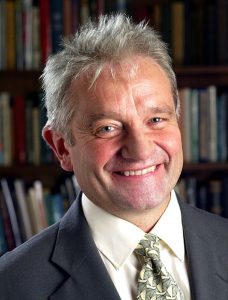
Picture: Paul Nurse was awarded the 2001 Nobel Prize in Physiology or Medicine along with Leland Hartwell and Tim Hunt for their discoveries of protein molecules that control the division (duplication) of cells in the cell cycle.
Spermidine is present in all living organisms and in all types of cells and is closely linked to cellular growth, production of nucleic acids and proteins or membrane stabilisation.
Polyamines influence chromatin structure and are involved in gene regulation, because polyamines – as positively charged cations- will bind to DNA and stimulate deacetylation of histone proteins. Transcription is controlled through histone proteins.
An increase in the rate of metabolism also sees an increase in the amount of spermidine in an organism. Likewise, when metabolism slows down, the amount of spermidine also decreases. In addition, the concentration of spermidine is age-related and gets lower with increasing age.
There are natural situations in which the spermidine concentration increases: growth, pregnancy, repair of muscle cells after vigorous physical exercise and the regeneration of red blood cells after blood loss or anaemia.
Sources:
Kazuei Igarashi, Keiko Kashiwagi: Modulation of cellular function by polyamines. In: The International Journal of Biochemistry & Cell Biology. Band 42, 2010, S. 39.
Mandal, A. Mandal, H. E. Johansson, A. V. Orjalo, M. H. Park: Depletion of cellular polyamines, spermidine and spermine, causes a total arrest in translation and growth in mammalian cells.In: Proceedings of the National Academy of Sciences.Band 110, 2013, S. 2169.
Spermidine increases the overall level of protein synthesis 1.5 to 2.0-fold
Soy spermidine plays an important part in the stimulation of protein synthesis.
Spermidine enhances the ability to synthesise RNA, is involved in the regulation at the level of genome transcription and stabilises proteins at translational level.
Proteins are produced in ribosomes, which are macromolecular protein factories.
The role of ribosomes in biosynthesis within the cell is to chemically link amino acids – there are 20 different naturally occurring amino acid building blocks- using peptide bonds to form a linear polypeptide chain which typically consists of several hundred amino acids. Protein synthesis is a step-by-step process in which ribosomes start production at one end of the polypeptide chain and finish at the other end.
For a protein to become active, the polypeptide chain first has to be “folded” into a particular three-dimensional pattern. This maturation process is complex and fascinating at the same time and has been the focus of generations of scientists. It is all down to interactions between the amino acids within the polypeptide chain, some of which happen within seconds whereas others may take minutes.
After amino acids are linked, the newly formed polypeptide chain has to pass through a narrow tunnel inside the ribosome before reaching the surface of this molecular machine. It is here, that the protein folding process takes place. Folding is a very complex process prone to errors leading to “misfolded” proteins which are either non-functional or, in the worst case, toxic to the cell.
Dr Madl (born in 1980), of Graz, is a structural biologist and particularly interested in signal transduction (cell signalling) (biomolecular NMR spectroscopy). Signal transduction is an essential process in all organisms and most proteins involved in this process are not folded. Malfunctioning proteins are the cause of many diseases and are also linked to ageing.
To counteract these problems, the cell possesses an arsenal of molecular chaperones, making up approximately 10 percent of all cellular proteins. Chaperones bind to and protect newly synthesised proteins until they have fully established their three-dimensional structure. They prevent unwanted protein aggregation and the synthesis of “mis-folded” proteins.
Spermidine has the ability to bind to DNA, RNA and various different protein molecules and is involved in a range of cellular processes such as transcription, RNA modification, protein synthesis and modulation of enzyme activity. According to some estimates, a very high percentage of polyamines are bound to nucleic acids, proteins and other negatively charged molecules through ionic interactions.
In summary, soy spermidine is involved in protein synthesis by boosting the binding of mRNA to ribosomes and autophagy, which makes amino acids available again after amino acid recycling and which are needed for protein synthesis.
A healthy heart
Soy spermidine has cardioprotective effects: it stabilises mitochondrial functioning, has anti-inflammatory properties, stopps ageing processes in stem cells and thereby reduces the incidence of cardiovascular mortality.
Supplementing with spermidine induces autophagy and prevents ageing of the heart.
Activation of autophagy through nutritional or pharmacological intervention slows down the process of cardiovascular ageing and promotes longevity.

Abbreviations: AP = autophagosome, APL = autophagolysosome, L = lysosome
A healthy sleep
Soy spermidine also influences our sleeping patterns. Those with an inadequate intake of spermidine have a delayed circadian rhythm.
Supplementing with spermidine can improve the sleep/wake cycle.
Regeneration of cartilage and intervertebral discs
Soy spermidine has protective and regenerative effects on joint cartilage and intervertebral discs. Spermidine normalises dysregulated autophagy and spermidine synthesis in aged and osteoarthritic cartilage cells.
Beautiful hair and skin
Soy spermidine improves complexion and functional properties of skin, hair and nails.
Soy spermidine promotes growth and regeneration of skin, hair and nails because it stimulates skin cells and skin appendages and counteracts skin ageing. Spermidine has been shown to be highly activating for healthy human skin fibroblasts and this was also accompanied by an anti-ageing effect.
Soy spermidine acts as an anti-inflammatory in acute and chronic inflammations; this is due to its antioxidative and lysosomal stabilising properties. Skin, hair and nails also benefit.
A diet rich in spermidine may protect from cancer
Epidemiological analysis and intervention studies have shown that not only life style choices but also dietary preferences and habits contribute to inhibit age-related diseases and senescence.
For example, eating more soybeans or soybean by-products is linked to a lower incidence of cardiovascular disease and malignant diseases such as breast or colon cancer.
Results indicate that substances in these foods play an important role in reducing the incidence of age-related pathologies.
Anti-oxidative polyphenols are substances which are thought to be candidates to be important for prolonged life expectancy. Genistein is an isoflavone found in soybeans and, being a natural estrogen receptor modulator, involved in prevention of osteoporosis. Genistein also significantly reduces the risk of breast and prostate cancer (https://mediatum.ub.tum.de/doc/603761/603761.pdf).
Soy spermidine lowers the level of insulin and reduces the risk of diabetes and obesity
Spermidine is involved in translation of insulin mRNA.
Spermidine is a known insulin sensitising agent and potentially delays the onset of or even prevent insulin-dependent diabetes.
There is some evidence that soy spermidine may lower the level of insulin. Insulin is a hormone which is produced by the pancreas and regulates the concentration of blood sugar. High concentrations of insulin are linked to a higher risk of diseases such as diabetes and obesity.
Several studies in animals and human cells have shown that spermidine positively influences the concentration of insulin. A study in mice has shown that supplementing with spermidine reduced insulin resistance and improved glucose metabolism. Another study showed that spermidine lowered the level of insulin in human cells by improving insulin secretion and insulin sensitivity.
Source:
Oka T, Ohtani M, Suzuki J. [Identification of novel molecules regulating differentiation and hormone secretion and clarification of their functional mechanisms in pancreatic endocrine cells]. Yakugaku Zasshi. 2010 Mar;130(3):377-88. Japanese. doi: 10.1248/yakushi.130.377. PMID: 20190522.
SOY PROTEIN
Without proteins, life would not be possible.
Amino acids are the building blocks of proteins and our body is dependent on an adequate supply of amino acids to synthesise proteins.
When compared to cereals, soy proteins are rich in lysine, an essential and nutritionally particularly valuable amino acid. Methionine and cysteine, the two sulphur-containing amino acids, are also essential amino acids but are present at lower concentrations than in cereals. Out of all free amino acids, arginine is present at particular high concentration, but asparagine, glutamic acid and aspartate can also be found, albeit at lower concentrations.
Soy protein is a valuable and particularly complete protein as it contains all essential amino acids which cannot be made by the body and must come from food. The amino acids score of 100 means means that this protein contains all essential amino acids in sufficient amounts to meet the needs of our body and promote protein synthesis.
The amino acids score is used to describe whether the amino acid composition of a particular protein can meet our body’s needs.
Soy protein stimulates muscle protein synthesis, muscle mass and muscle function
It could be shown that a dietary intake of soy protein increases protein synthesis and muscle protein synthesis in those who work out regularly. An increase in muscle mass and muscle protein synthesis is equally seen in the elderly and is a result of the positive influence of soy protein on protein synthesis.
A healthy muscular system is critical for a healthy body and a good a good quality of life. The muscular system is the largest metabolic organ in our body and is not only essential for our mobility but also acts as a storage facility for protein which may be used by our body in emergency situations. A higher muscle mass helps to burn fat, prevent diabetes mellitus type 2 and has also been shown to increase life expectancy.
Loss of muscle mass is already seen in young adults and the rate of loss increases in people over the age of 50. We lose approximately 50% of muscle mass and muscle strength between the age of 20 and 70.
According to the “Bundesministerium für Gesundheit“ (BMG, Ministry of Health), a third of those over 65 living at home have at least on fall a year. For those living in nursing homes, it is 50%. Although most people in this age group do not hurt themselves seriously, many fear to fracture their femur and become bedridden as a result.
An early dietary supplement of soy protein and soy spermidine is needed.
Soy contains more than 40% of high-quality protein
Soy is a high-quality protein. High-quality proteins contain all essential amino acids and therefore all building blocks for protein synthesis in our body. Essential amino acids in soybeans fulfil these criteria and therefore the amino acid score of soybeans is 100.
In 1993, the FDA introduced the “Protein Digestibility Corrected Amino Acid Score” which in addition takes into account how easily digested a protein is and -again- soybeans were awarded the perfect score of 1.0 (Henley, et al., 1994).
Soy protein, just as soy spermidine, promotes protein synthesis
Soy protein promotes protein synthesis as well.
Proteins are built from amino acids and our body needs sufficient amounts of these amino acids for protein synthesis. Soy protein is an excellent source for these amino acids as it contains all essential amino acids which cannot be produced in our body and therefore have to be taken in from food.
It was shown that supplementation of soy protein increases protein synthesis in your body, especially after physical activity like weight training. Soy protein can also help to increase muscle mass, improve muscle function and prevent muscle loss in old age.
Some studies have also indicated that soy protein is equally good at promoting protein synthesis as other sources of proteins like milk protein or whey protein. Furthermore, it is also an alternative to animal derived proteins and may be recommended as “meatless meat”.
On reflection, soy protein can help to increase protein synthesis in our body and thereby support growth and repair of muscle tissue and help to prevent loss of muscle mass in old age.
Soy protein lowers levels of saturated fatty acids and cholesterol in plasma
Reducing levels of tri-glycerides is an established effect of soy protein and many studies have suggested that this effect is attributed to soy protein b-conglycinin fraction (Aoyama et al., 2001, Moriyama et al., 2004, Kohno et al., 2006, Tachibana et al., 2010).
Which isoflavones are found in soybeans?
Soybeans contain a variety of isoflavones, for example genistein, daidzein and glycitein. These isoflavones belong to the class of phytoestrogens which are produced in plants and have a structure similar to the female hormone estrogen. Because of their structure, isoflavones may bind to the estrogen receptor and in turn have estrogen-like effects in our body.

Figure: Genistein is a 7-hydroxyisoflavone with additional hydroxy groups at positions 5 and 4′. An isoflavonoid derived from soy products.
Genistein is the most abundant isoflavone in soybeans. Genistein is mostly taken up with sprouts and stem vegetables (43%) or soy products (24%). Another 33% is taken up from other foods but with each with an individual percentage of less than 10%. It has anti-oxidative effects and may act as an anti-inflammatory. In addition, genistein was shown to have potentially positive effects on bone health, cardiovascular health and cognitive abilities. The higher the amount of genistein in the diet, the lower the risk of developing breast cancer.
Another isoflavone found in soybeans is daidzein. The main source of daidzein is coffee (47%) followed by sprouts and stem vegetables (25%). It is converted to equol in our body which was also shown to have estrogen-like effects. Daidzein and equol may have a positive influence on bone health and reduce the risk of developing age-related diseases such as breast cancer or prostate cancer.
Glycitein is the third important isoflavone in soybeans. Its action is similar to genistein and daidzein including the potential positive effect on bone health and cardiovascular health.
Impact on developing breast cancer
The higher the intake of genistein, the lower the risk of developing breast cancer (up to 53%). In addition, the risk of developing premenopausal breast cancer is lower in the top genistein dietary intake quartile. The change in risk is significant in both genistein and daidzein.
Together, daidzein and genistein, are associated with a significantly lower risk that can already be seen in the third quartile. For both, the trend of a lower risk with increasing dietary intake is significant.
For the sum of all isoflavones and the sum of all phytoestrogens there is no correlation to the risk of developing premenopausal breast cancer.
When sensitivity is analysed, daidzein lowers the risk of breast cancer already in the second quartile. Total isoflavone intake in the third quartile correlated with a significantly lower risk.
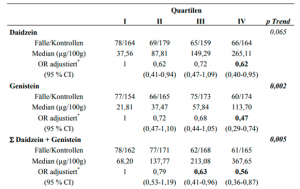
Figure: Premenopausal women (n=944) took phytoestrogens as a supplement for a breast cancer study. https://mediatum.ub.tum.de/doc/603761/603761.pdf
Are there any health risks associated with eating soybeans?
Soybeans are a healthy source of plant-based proteins, fibre, vitamins and minerals. In general, they are safe to eat and are available as tofu, soy milk, edamame or soy protein.
People with an underactive thyroid and soy products
There are some limitations for eating soy in people suffering from hypothyroidism. Eating large amounts of soy products can impair thyroid function in those with hypothyroidism because soy, just like broccoli, cabbage and millet, contains isoflavones which are known goitrogens, i.e., they are substances that may lead to goitre. Goitrogens are substances that interfere with the production of thyroxin and trigger the release of thyroid stimulating hormone (TSH) from the pituitary gland. TSH in turn promotes growth of thyroid tissue and can cause goitre. It is recommended that those with an underactive thyroid limit their consummation of soy and contact their healthcare professional to discuss ways of increasing their level of thyroid hormones.
Soy products and breast cancer patients
Studies have indicated that soy may have estrogen-like effects and therefore may potentially interfere with hormone therapy in women suffering from breast cancer or other hormone-related cancers.
National and international societies agree that consuming 1-2 portions of soy a day is safe for women with breast cancer or those that had breast cancer. Example: one portion is equal to 250ml soy milk or 100g of tofu and the ingested amount of isoflavones is approximately 25-50 milligrams.
There is no reason to remove soy-based foods from your diet if you have been prescribed tamoxifen or so-called aromatase inhibitors for breast cancer therapy.
Allergic reactions
As a whole, soy is healthy and nutritious and can be consumed safely by most people within reason. As with any food group, it is important to consider individual allergic reactions and intolerances.
The allergenic substances in soy powder are glycinin and beta-conglycinin. The majority of soy allergies are caused by these two proteins.
Some have reported cross-reactions between soy and other foods such as cereals containing gluten and cereal products that contain gluten, peanuts, lupines and its products, peas or beans. Those with a known soy allergy should be careful when consuming these foods.
Spermidine supplementation is necessary from early adulthood on
Bio-synthesis of spermidine is dependent on the presence of S-adenosylmethionine (ademetionine)
Our body’s spermidine stores are getting depleted from early adulthood onwards. Everyone above the age of 40 needs an extra source of spermidine because the level of spermidine is already reduced by a third when compared to the level seen in juveniles. At about the age of 80, our body has lost about two thirds of its physiological spermidine level.
1 heaped table spoon (25ml) soy powder is equal to > 1.7mg spermidine.

Figure: Bivariant correlation analysis in men and women shows a highly significant negative correlation between serum spermidine levels and age (p<0.001).
From: Pekar T, Wendzel A, Flak W, Kremer A, Pauschenwein-Frantsich S, Gschaider A, Wantke F, Jarisch R. Spermidine in dementia: Relation to age and memory performance. Wien Klin Wochenschr. 2020 Jan;132(1-2):42-46.
Recommended dosage
For daily use:
Mix a heaped table spoon of Soyup spermidine powder with at least 200ml water. You can use more water if you wish.
Soyup spermidine powder can alternatively be mixed with cream cheese, yogurt, milk or fruit juice.
Epilogue for sustainability
Johann Vollmann: SOY VISIONS
Instead of using soybeans as animal feed, the total world soybean harvest in 2020 would be sufficient to meet approximately 75% of the world’s protein requirement for a whole year. Of course, this idea is unrealistic, science fiction, as it neither takes into consideration social nor economic circumstances like cost of production or rules of the free market. What is does, however, is to make the magnitude of the available soy produce visible and how this relates to the nutritional needs of the world’s population.
The human body requires approximately 0.8g of protein per kg body weight for muscle development, cell functions and energy production. For an adult weighing 80kg this equals to 64g a day or 23.4kg a year. In 2020, the total soybean harvest came to 353.5 million tons which equals 141.4 million tons of protein if protein content of 40% is assumed. This is sufficient to meet the protein requirement of just over 6 billion people. Of course, no one is able or would want to live exclusively on soy protein, but because carbohydrate rich foods such as cereal, maize, rice or potatoes also contain a certain amount of protein, a considerably lower area for the cultivation of soy would be sufficient. In this scenario, a reduction in livestock numbers and the reduced use of animal-based food products would result in climate neutral food production.
Source available on request: johann.vollmann@boku.ac.at
Johann Vollmann is an associate professor for plant breeding and teaches at the Universität für Bodenkultur (University of Natural Resources and Life Sciences) in Vienna. His research focuses on applied genetics with the aim of improving the content of oil, protein and further health beneficial substances in soybeans and oilseed crops. BOKU – Universität für Bodenkultur Wien, Dept f. Nutzpflanzenwissenschaften, Institut f. Pflanzenzüchtung, Konrad Lorenz-Str. 24, 3430 Tulln an der Donau, Austria
Source: Johann Vollmann, Sojabohnen als Quelle für Spermidin (Soybeans as a source of spermidine). Article from: Johann Vollmann – SOJABOHNEN ALS QUELLE FÜR SPERMIDIN, published in:
Wissen, das hilft: MITOCHONDRIEN – GESUNDHEIT: Epigenetik & der sanfte Weg gesund zu sein – November 22nd 2022
by Dr. Eduard Rappold (Author)
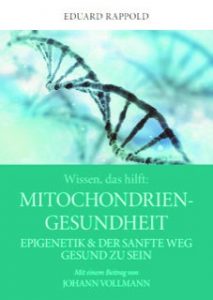
https://www.amazon.de/Wissen-das-hilft-MITOCHONDRIEN-GESUNDHEIT/dp/3991395940
NUGENIS GmbH
– Touchpoint Epigenetics –
c/o LEBENSAFT STB & WTH GmbH
Dr. med. Eduard Rappold, MSc
CEO
Prinz Eugen-Straße 66, 1040 Wien
FN 439071v beim HG Wien
+43/664/953 06 99
eduard.rappold@nugenis.eu
www.nugenis.eu
www.epigenetik.at
